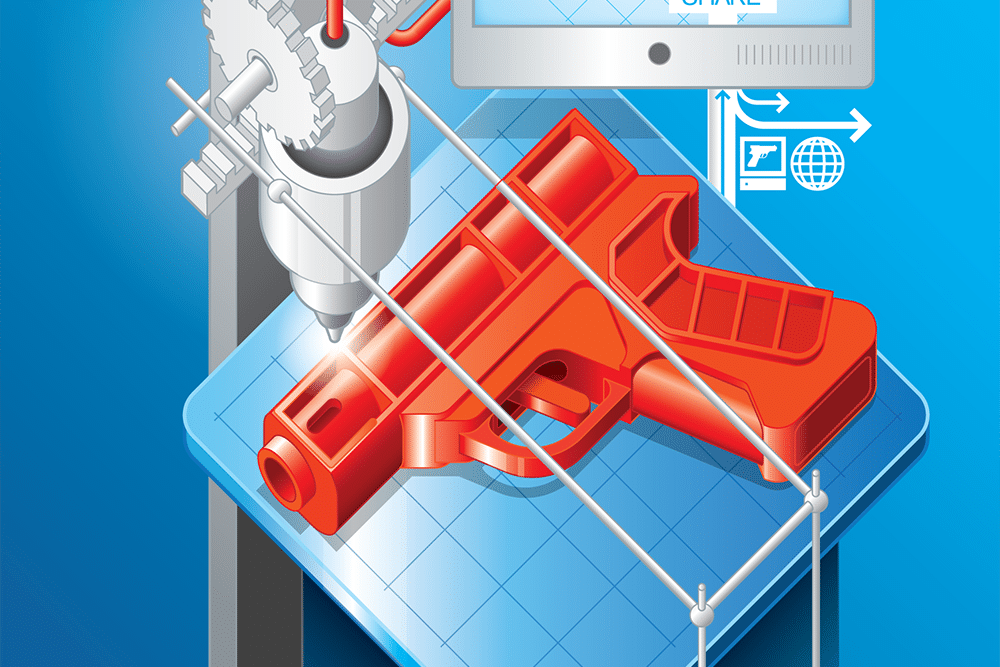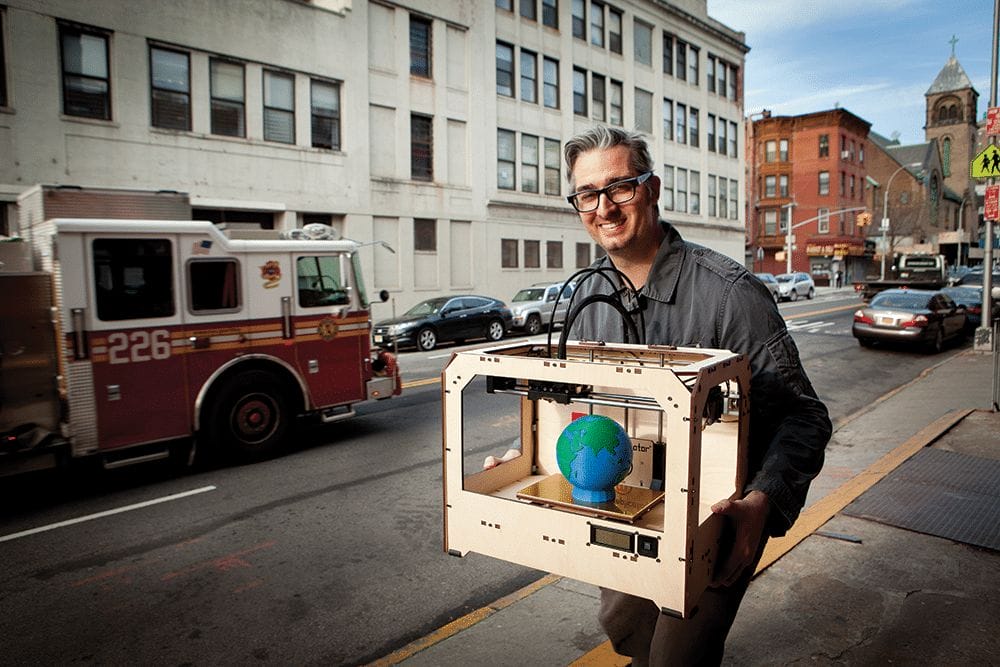Weapons of mass production
Could 3D printers be used to create cheap, untraceable guns that anyone with an internet connection could manufacture at home? As Defence Distributed launched its campaign to build a universal Wiki Weapon, Alan Rutter investigates how Bre Pettis and his Replicator machine are set to revolutionise the world of manufacturing, ushering in an era of DIY Nikes and printout pistols

Illustrations: Christian Tate
27th July 2012 (Taken from: #6)
Getting hold of a gun in America is harder than you might think. There are forms to fill in, IDs to show, waiting periods to endure, serial numbers to record. And you have to schlep all the way down to the gun store to make your purchase too.
Cody Wilson, a student at the University of Texas and the director of Defense Distributed, saw a way round all these inconveniences. Wouldn’t it be better, he suggested in an online promo video for his project released on 27th July, if you could just create a working gun in the comfort of your own home, using a freely distributed blueprint, on 3D printing equipment that costs only a few thousand dollars?
Wilson’s plan wasn’t far fetched – the technology to create a gun in your kitchen already exists, and is perfectly affordable. All that is necessary is for a schematic to be produced which can be fed into a 3D printer, creating weapon parts that you can then put together. “The result,” said Wilson, “will be an easily accessible and replicable design shared with the world. At this point, any person has near-instant access to a firearm through the internet.”
If people can freely share 3D blueprints and then churn out their own firearms in cheap plastic then the weapons become untraceable”
Defense Distributed raised $20,000 in crowdsourced funding to pursue Wilson’s dream, which was enough to rent the equipment needed with money left over for the development of the design itself. Wilson had no special permits, no factory space, no access to exclusive tech. As it happens, he never actually made the gun – but this was down to a supplier dispute rather than any legal intervention. When Stratasys, the company leasing him the printer, got wind of his intentions they sent representatives round to take the machine back.
Even in gun-loving America, the right to print arms is a terrifying concept. If people can freely share 3D blueprints and then churn out their own firearms in cheap plastic, free from serial numbers or any form of registration, then the weapons become untraceable.
The US is far from ready to deal with the idea of printable weaponry. Technically, it’s not illegal to manufacture guns at home, providing you’re not going to sell them – creating a huge grey area for would-be weaponsmiths. But there are exceptions. Machine guns are illegal to manufacture, and there’s a stipulation that “any other weapon, other than a pistol or a revolver… capable of being concealed on the person” will be subject to review by the Bureau of Alcohol, Tobacco, Firearms and Explosives (ATF).
And there is a further complication. Where previous attempts at cheap plastic guns relied on producing the item partly in plastic then adding off-the-shelf metal parts such as the barrel, Wilson’s vision is wholly plastic (aside from the bullets). This creates technical problems: unless Wilson demonstrates otherwise, the heat involved in propelling a bullet will likely melt the barrel after a single shot. He recognised this in his project pitch, saying that the key to success was large scale trial-and-error testing of alternative designs. “Basically we need to break some guns,” he said.
The legal status of the Defense Distributed gun remains unknown, or at least untested – by erring on the side of caution, Stratasys saved the ATF a highly complicated test case. But despite yelps of protest from anti gun pressure groups, the Wiki Weapon project has received widespread support online, largely from “right to bear arms” apologists who agree with Wilson that “every dollar contributed to this project is also a vote to export the protections of the Second Amendment to the entire world.”
Beyond the bullets
While Wilson’s pet project is a cause for concern, the potential impact of 3D printing goes far beyond DIY arms manufacturing. Anyone equipped with a 3D printer and a 3D scanner (which use lasers to create digital designs of objects placed in front of it) will soon be in a position to copy and print almost any plastic object.
Leading the charge for the democratisation of production is MakerBot Industries, founded in Brooklyn in 2009 by Bre Pettis, Adam Mayer, and Zach “Hoeken” Smith, with the aim of producing an affordable, desktop 3D printer. They’ve brought several printers to market – the Thing-O-Matic, the Replicator, and (in September) the Replicator II. All are about the size of a mini-fridge, and have a moving print head which deposits a thermoplastic called acrylonitrile butadiene styrene (ABS) in thin layers. As the head rises the layers are gradually built into a 3D object, which can be anything between the size of a cupcake and a loaf of bread.

Bre Pettis
The potential uses for 3D printing are endless, and an entire ecosystem has grown up around the technology. Companies such as Autodesk are ensuring that their Computer Aided Design (CAD) software meshes seamlessly with the printers. Cloud services like Sculpteo allow users to upload their blueprint files and have them 3D printed at a factory and delivered to their door.
Anyone equipped with a 3D printer and a 3D scanner will soon be in a position to copy and print almost any plastic object”
Artists like Jordan Jon Hodgson have adopted 3D printing as their chosen form, constructing intricate sculptures that would be impossible to produce using any other method. Paleontologists are creating exact replicas of fossils and skulls from MRI scans. Architects are prototyping new building designs rapidly and exactly. And then there’s RepRap, an open-source project to build a printer that can print the parts necessary to build… another printer.
“The people who are going to be affected first are the people who make things already – engineers, industrial designer, artists or architects,” Bre Pettis tells me. “They know about this technology and they already know what it can do. But they’re used to
the tools costing hundreds of thousands of pounds. Now you can have a MakerBot printer plus software for, like, £1.800.”
The printers’ high speed and low cost has a dramatic impact on the design and build process. “The old way of designing a product is that you design it, you send it off to get made – that takes a couple of weeks. You get it back, it’s wrong, you change the model, you send it off,” says Pettis. “Your iteration time is weeks or even months. With a MakerBot, you could do an iteration in half an hour.”
Enter the Object Pirate
The creativity of the 3D printing movement is currently fuelled by dabblers being able to share their designs. MakerBot has its own online forum, Thingiverse – and notorious file-sharing site Pirate Bay also has a 3D design section it’s calling Physibles. But if you’re in the business of making things out of plastic, there’s an obvious problem with people freely sharing files based on your design: object piracy.
In late 2011, American graphic artist Thomas Valenty bought a MakerBot printer. He decided to test it out by designing two of his own models inspired by the the Warhammer 40,000 tabletop game, owned by UK company Games Workshop. Valenty created a tank and a two-legged war mecha (a humanoid, walking tank) from scratch, and when he was happy with them he shared the files on Thingiverse. Games Workshop saw this, and sent Thingiverse a takedown notice: Thingiverse complied and removed the offending files.
 Valenty’s case isn’t clear-cut because his designs weren’t copies, they were models in the same style as the Warhammer 40,000 universe. But that won’t stop some manufacturers – desperate to protect their existing business models – from adopting a draconian approach. A patent has already been filed in the US for a manufacturing control system that could be built into a 3D printer to check files against a list of existing patents and trademarks. If this is implemented, it will be an attempt to draw a line in the sand – although it may well prove ineffective, particularly for businesses like Games Workshop that count ingenious hobbyists and mod-making back-room tinkerers as their core demographic. And of course patents are not the same as copyright: for a start, they often expire after 20 years, so if you want to print out a load of toys from the 80s, for example, you’ll probably be in the clear.
Valenty’s case isn’t clear-cut because his designs weren’t copies, they were models in the same style as the Warhammer 40,000 universe. But that won’t stop some manufacturers – desperate to protect their existing business models – from adopting a draconian approach. A patent has already been filed in the US for a manufacturing control system that could be built into a 3D printer to check files against a list of existing patents and trademarks. If this is implemented, it will be an attempt to draw a line in the sand – although it may well prove ineffective, particularly for businesses like Games Workshop that count ingenious hobbyists and mod-making back-room tinkerers as their core demographic. And of course patents are not the same as copyright: for a start, they often expire after 20 years, so if you want to print out a load of toys from the 80s, for example, you’ll probably be in the clear.
So is 3D printing a threat to manufacturers? And if patents or trademarks become a battleground, could this scupper the booming creativity around the movement? “People do say about Thingiverse, ‘This is all fun and games until somebody uploads the design for a Nike shoe. Then it’s game over,’” says Pettis. “The funny thing is, I told Nike about this, and they said, ‘Hmm. Maybe we should be the first ones to do that.’”
As iTunes demonstrated with music, the only real way to counter the illicit sharing of files is to create a paid-for environment that’s attractive and easy to use – and brands who have seen what happened to the record labels may well view 3D printing as an opportunity rather than a threat. “There’s a way to share that minimises the risks associated with sharing, and gets a lot of value back for a brand,” says Pettis. “But it’s the frontier, it’s the beginning – people have to try it out, and we have to see what’s happening. The brave brands that are willing to take risks will do things first. I think you’ll see that piracy is not a problem – obscurity is the true problem. Who wants to be obscure when you have the opportunity not to be?”
In the short term, companies that rely for their revenue on creating plastic products will need a strategy for dealing with this shift. In the near future, if you need a replacement battery cover for your remote control or a case for your iPhone you’ll simply go online, download a file (paid-for or otherwise), customise it if you want to, and hit print. “I think that the most interesting way to think about the future is to look at what kids are doing,” says Pettis. “Kids come up to us and say, ‘Can I make Lego?’. And we say, ‘Yeah.’ And they say, ‘Get out of my way.’”
“Kids are constrained financially – they can’t buy the things that they want. But if they have a machine that can make the things that they want, I think we’re going to see that they solve all these problems that we didn’t even know are problems. We grew up thinking: What shoes should I buy? What choice should I make? Where do I go shopping? They’ll grow up thinking: I can do it my way, and make the things I need rather than choosing from the options available. Imagine yourself at age ten, and you’re able to make anything.”
A generation of creators, rather than consumers. More than printable guns or the acceleration of object piracy, this is how 3D printing just might really change the world.
Slow Journalism in your inbox, plus infographics, offers and more: sign up for the free DG newsletter. Sign me up
Thanks for signing up.








